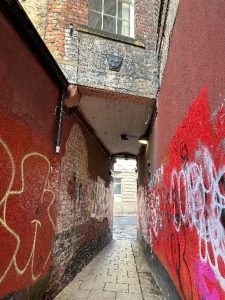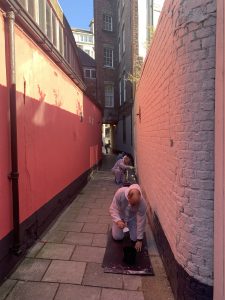True Solicitors volunteers in Forth Lane project
7 October 2024
On Thursday 3rd October, a small team of willing volunteers from our team took part in an exciting painting project with NE1 to prepare the space for a vibrant urban outdoor gallery in Forth Lane.
Our involvement in the project was significant given that the right hand side of the wall we painted was in fact the side of the original Gorman Hamilton office, with True Solicitor’s having started life as Gorman Hamilton almost 30 years ago.
The project is being run in collaboration with Newcastle Arts Centre, Creative Central NCL and NE1 Ltd. With multiple creative opportunities, the projects could transform this historic alleyway, turning it from a neglected passageway to a destination. Part of this project is to fund one large-scale mural to be painted onto the Eastern elevation on the Westgate Road end of Forth Lane.
The Theme for the urban gallery is ‘Pleasure Garden’. This project sits within a wider theme of the public art portfolio of the City called “Hidden City”, including works that reveal the histories and hidden stories of the city.
About Creative Central NCL
Creative Central NCL is a five-year project led by Newcastle City Council and funded by the North of Tyne Combined Authority. Now in its second year, it aims to support independent artists and creative businesses in central Newcastle with investment, grants, skills development, and opportunities for growth. You can find out more about Creative Central NCL here
About Forth Lane
On the west side of the lane is 67 Westgate Road (grade II listed). Above the lane is a town boundary stone (also grade II listed).
The Forth was a tree-lined square, south of the Forth Gate, which was between Gunner Tower and Pink Tower. The Forth was in use by the 1500s. It began as a square field of over four acres, fenced to keep animals out, and used by people of all ages for their leisure and pleasure: a playground, dancing square, sports field, a meeting place and a place to stroll and enjoy the view. The Forth must have had great views across the valleys and the river. By the early 1700s it was reached by a tree-lined walk from the Forth Gate, Forth Lane.
For hundreds of years, at Easter and at Whitsuntide, the mayor and aldermen would go in a grand procession to the Forth. A house was built on the north side of the park, at public expense, for the keeper. After the Restoration, the Forth House was extended, becoming a large tavern.
As factories were being built adjacent to the river, and Newcastle’s population was exploding, spreading beyond the town wall, the Forth lost its views, and was no longer the quiet leisure park. As the cattle market next to the Forth needed more space in 1842 the last tree was uprooted as the cattle market expanded into the Forth.




